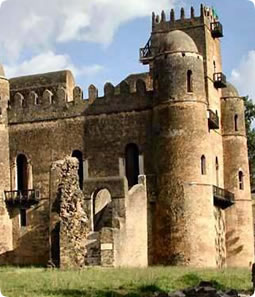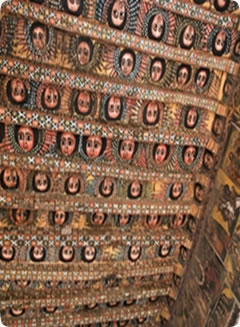Gondar, the Camelot of Africa
King Fasilides established the historical Gondar as the capital of Ethiopian in 1636. King Fasilides (1632-1667) diverted the temporary capital city that was established by his father, Emperor Susynos, in Gorgora. He chose Gondar because the area is free of malaria, good for defensive purpose and good climatic condition. Gondar used as the capital city of Ethiopia up to 1855 until Emperor Teodros diverted the capital. Gondar is noted for its wonderful castles on the continent Africa, arts, paintings and architecture.
The Castles Compound
 The castles compound (Royal enclosure) of the emperors of the first Gondarine period lies on 70000 square metre and is surrounded by twelve gates basalt wall. Historically, the first castles were built by Portuguese in Gorgora (the castle of Emperor Susynos 17th c.) and Guzera Castle (the castle of Emperor Sarsa Dengil 16th c.). However, the castles in Gondar were built by Ethiopians except Portuguese design influence.
The castles compound (Royal enclosure) of the emperors of the first Gondarine period lies on 70000 square metre and is surrounded by twelve gates basalt wall. Historically, the first castles were built by Portuguese in Gorgora (the castle of Emperor Susynos 17th c.) and Guzera Castle (the castle of Emperor Sarsa Dengil 16th c.). However, the castles in Gondar were built by Ethiopians except Portuguese design influence.
King Fasilides Castle (1632-1667) – a three sections (two stories) castle with square plan (25 m X 25m) and 32 m height. It is the most magnificent and elegant castle of Gondar.
The Archive Castle – King Fasil built it for collection of documents.
Yohannes Castle (1667-1682) – It is characterized as ‘love castle’ and built by Emperor Yohannes, the son of King Fasil.
Emperor Iyasu I (1682-1706) - it is ‘saddle castle’. Iyasu is the son of Emperor Yohannes. Traditionally it is said this castle is as fine as the palace of King Solomon of Jerusalem. It was decorated with Vatican mirrors, gold leaf, precious materials and paintings. Unluckily, these decorations partially can not be seen because of earthquake in 1704 and the British Force bombardment to expel out the Italian Forces during the World War II.
David II (1716-1721) – his castle is known as the ‘house of song.’ Because festival ceremonies with music was held here.
On the western side of Emperor David castle, there is lion’s cage. The last lion died in 1992.
Bakaffa (1721-1730) – It is large reception hall. Horses’ stables stand in front of it.
Empress Mentuab and Iyasu II (1730-1755) – it is the great two stories palace with Ethiopian crosses decoration on the western wall in referring to Axumite, Lalibela and Gondar crosses.
In general, the castles compound also consists of other buildings like the Turkish style bath, and churches.
Churches of Gondar
 There were 44 churches in Gondar. Churches of Gondar are known for their wonderful Gondariane paintings. Debre Berhan Selassie and Kusquam are the most visited churches in Gondar.
There were 44 churches in Gondar. Churches of Gondar are known for their wonderful Gondariane paintings. Debre Berhan Selassie and Kusquam are the most visited churches in Gondar.
Debre Berhan Selassie Church
It is literally translated as ‘Trinity at the mount of light’. It was constructed during the reign of Iyasu I. It is noticeable for high-fortified wall with tower all around. This church is unique in both mural and ceiling paintings. It is the only church in Ethiopia to have painting on the ceiling with faces of angles in all directions. The biblical theories scene on the four walls with typical Gondarian painting is unbelievable.
Kusquam
Kusquam is found at the outskirt of Gondar. Empress Mentuab built both the church and castle here. The church dedicates to St. Mary. Mahdists destroyed the original church in 19th century. The new one is also worth to visit. The skeletal remains of Empress Mentuab, Emperor Iyasu II, and her grand son Iyoas are found underground inside the church.
The impressive banquet hall castle with outer wall cross relief is very interesting to visit. THe Empress also built Separate Castle for bedrooms. According to local people stroy, there is a room inside this castle where the 17th Century schotish traveler James Bruce stayed for five years.
The Bath of King Fasilides
The 50 m X 30 m and 2.5 m deep, in the center of which stands the two-storied square castle is known as the bath of King Fasilides is now using as the site of Ethiopian epiphany celebration.
Back to Top




 The castles compound (Royal enclosure) of the emperors of the first Gondarine period lies on 70000 square metre and is surrounded by twelve gates basalt wall. Historically, the first castles were built by Portuguese in Gorgora (the castle of Emperor Susynos 17th c.) and Guzera Castle (the castle of Emperor Sarsa Dengil 16th c.). However, the castles in Gondar were built by Ethiopians except Portuguese design influence.
The castles compound (Royal enclosure) of the emperors of the first Gondarine period lies on 70000 square metre and is surrounded by twelve gates basalt wall. Historically, the first castles were built by Portuguese in Gorgora (the castle of Emperor Susynos 17th c.) and Guzera Castle (the castle of Emperor Sarsa Dengil 16th c.). However, the castles in Gondar were built by Ethiopians except Portuguese design influence.  There were 44 churches in Gondar. Churches of Gondar are known for their wonderful Gondariane paintings. Debre Berhan Selassie and Kusquam are the most visited churches in Gondar.
There were 44 churches in Gondar. Churches of Gondar are known for their wonderful Gondariane paintings. Debre Berhan Selassie and Kusquam are the most visited churches in Gondar.